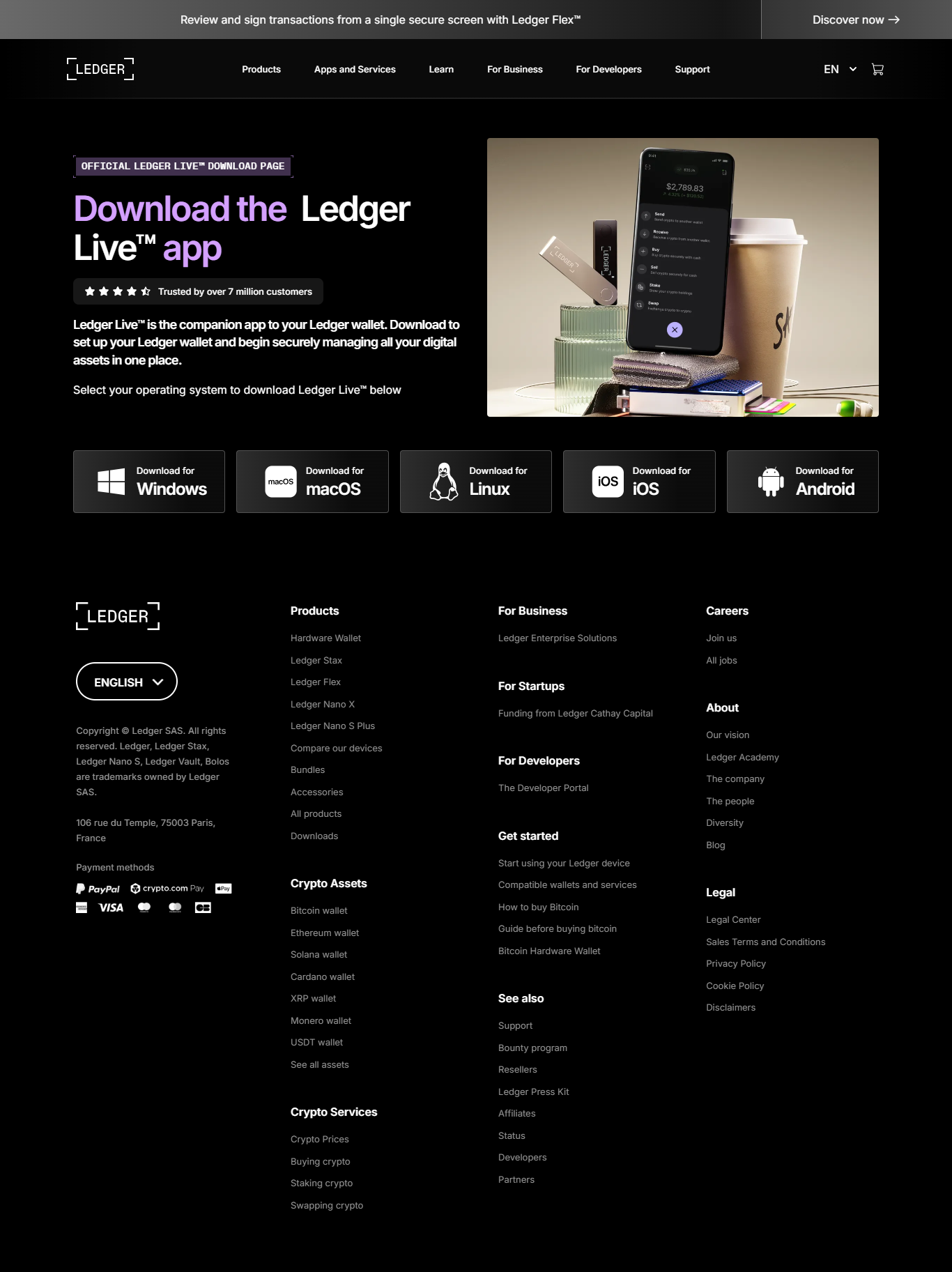What is Ledger®Login?
Ledger®Login is the process of accessing your crypto through the official Ledger Live application while using a Ledger hardware wallet (for example, Ledger Nano S Plus, Ledger Nano X, or Ledger Stax). Unlike web services, Ledger Live does not store your private keys on servers — your keys remain isolated inside the hardware device. “Logging in” therefore means connecting and authenticating your physical device and confirming actions directly on its secure screen.
This model emphasizes self-custody: you hold the keys, you control the assets. Ledger Live is the interface that reads blockchain data and requests cryptographic signatures from your device when needed.
Why hardware-based login matters
Software-only wallets and exchange accounts are vulnerable to phishing, credential theft, and server breaches. A hardware wallet provides these advantages:
- Keys never leave the device: Private keys are generated and stored in a secure element on the hardware wallet.
- On-device verification: Every important action (addresses, amounts, fees) is displayed on the device to confirm before signing.
- Reduced attack surface: Even if your computer is compromised, attackers cannot sign transactions without the physical device and PIN.
Before you begin — official downloads & verification
Always obtain Ledger Live from the official start page: Ledger.com/Start. Verify the app publisher in app stores (developer: Ledger SAS) and avoid third-party installers or APKs. Bookmark the official start page to avoid phishing links in the future.
Tip: If a website or email asks for your 24-word recovery phrase, it is a scam — Ledger will never request it.
Install Ledger Live & initial setup
- Visit Ledger.com/Start, download the desktop installer for Windows, macOS, or Linux, or install the mobile app from the official store.
- Launch Ledger Live and follow the onboarding wizard to set preferences and security options (app password, analytics, etc.).
- Connect your Ledger device with the supplied cable (or use Bluetooth for Nano X when pairing to mobile).
- Initialize the device: create a device PIN directly on the device and write down the 24-word recovery phrase shown on the device screen. Store the seed offline and never digitize it.
- Run a Genuine Check in Ledger Live (Manager → Verify device) to confirm the hardware is authentic.
The Ledger®Login flow — desktop
On desktop, the login flow generally follows these steps:
- Open Ledger Live. If you enabled a local app password, enter it to unlock the interface.
- Connect your Ledger hardware wallet via USB and unlock it by entering the device PIN on the hardware itself.
- Open the specific blockchain app on your device (for example, Bitcoin). Ledger Live will detect the app and allow account synchronization.
- View balances and initiate transactions. Any send operation requires explicit on-device confirmation before the transaction is signed and broadcast.
Viewing portfolio data without the device is possible if you disable app password protection, but you cannot sign or send funds without the connected Ledger and the PIN.
Ledger®Login — mobile pairing
Mobile users can manage assets on the go while keeping hardware-level security:
- Install Ledger Live Mobile from the App Store or Google Play (verify the publisher).
- Enable app security (PIN, Face ID, fingerprint) for local protection.
- Pair your Ledger device: Nano X pairs via Bluetooth inside Ledger Live; Nano S Plus can connect via USB OTG on supported Android devices.
- Enter the device PIN on the hardware when prompted and approve pairing. All transaction approvals still occur on-device.
Tip: Keep Bluetooth off when not pairing to reduce exposure on mobile devices.
Signing transactions safely
Ledger Live prepares the unsigned transaction locally and sends it to your Ledger device for signing. The device displays the exact recipient address, amount, and fee. It is essential to verify every detail on the device screen before approving. Only after you confirm on the device will the signed transaction be broadcast to the network.
Warning: If the address or amount on the device differs from what you entered in the app, cancel immediately. Approve only what appears on the device display.
Common login issues & troubleshooting
Try a different USB cable or port, avoid USB hubs, restart Ledger Live and the device, and confirm Ledger Live is up to date.
Forget the device in your phone’s Bluetooth settings and re-pair through Ledger Live. Keep devices close while pairing.
Clear the app cache (Settings → Help → Clear cache), reinstall from the official site, and restart your computer or phone.
Reset Ledger Live and reconnect the hardware wallet. Your funds are safe because keys remain on-device and can be restored via your recovery phrase.
Lost device & recovery
If your Ledger device is lost, stolen, or damaged, your crypto is still recoverable using the 24-word recovery phrase:
- Purchase a new (authentic) Ledger device or compatible wallet.
- Choose “Restore from recovery phrase” during setup and enter your 24 words on the new device.
- Reinstall Ledger Live and add your accounts — balances will reappear because funds live on-chain, not on the device.
Important: If your recovery phrase is lost or exposed, your funds are at risk. Ledger Support cannot recover a lost seed.
Security checklist & best practices
- Always download Ledger Live from Ledger.com/Start or official app stores.
- Never enter or share your 24-word recovery phrase — Ledger will never ask for it.
- Verify all transaction details on the Ledger device screen before approving.
- Enable local app password or biometrics on shared devices for extra privacy.
- Keep firmware and Ledger Live updated for security patches and improvements.
- Store your recovery phrase offline, consider a metal backup for durability, and keep multiple secure copies in separate locations.
Getting official help
If you need assistance after trying the troubleshooting steps above, consult the official Ledger Help Center at support.ledger.com or use the in-app Help widget. Beware of unsolicited messages claiming to be support — legitimate support will never ask for your recovery phrase or private keys.
